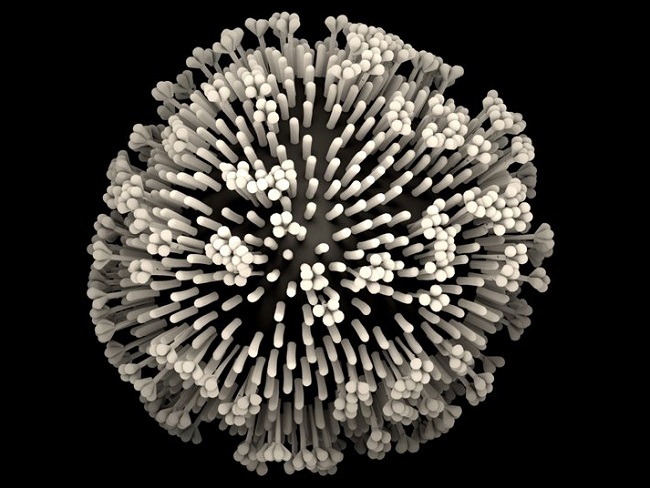The human genome is scattered with endogenous retroviruses and retroviral-like components, called retroelements. These retroelements make up 42% of the genetic code. Within these retroelements is a subgroup named endogenous retroviruses (HERV) that make up 8% of the human genome. The amount of genetic real estate that HERV hold is substantial when one considers that only about 2% or so of the genome codes for protein or functional genes. These viral genes (and their products) are part of us, suggesting they must serve a purpose, and as we will see later, they do indeed.
HERVs are genetically very similar to exogenous retroviruses, such as HIV, and utilize ribonucleic acid (RNA) to carry their genetic material. They reside within the human deoxyribonucleic acid (DNA) as a provirus and are considered a normal part of human genome. They are mostly inactive or non-functional but some can be activated from the genome and are able to produce what are called virion particles. Virion particles are viral particles capable propagating (infecting) among cells. HERV virion proteins, like many endogenous agents, can be activated with viral infections, inflammation, cytokines, and steroid hormones among other environmental factors. HERV are also strongly associated with multiple sclerosis and other neurological disorders as well as schizophrenia. In fact, they were first termed Multiple Sclerosis Associates Retroviruses (MSRV).
Retroviruses and Human Reproduction
Retroviral-derived genes being 8% of our DNA might be convincing for some, that viral proteins are part of us. However, if the latter is not convincing for the reader, then consider that endogenous retroviral gene promoters and protein products regulate human placental formation and embryogenesis. These products are requisite components of successful reproduction.
Let us first briefly discuss some aspects of retroviral components – the LTR. A type of retroelement called a Long Terminal Repeat, or LTR, is a retroviral-associated genetic sequence. The LTR functions as a promoter that is utilized by retroviruses, such as HIV, to regulate viral protein production. A promoter is a DNA sequence used to open certain genetic programs. In other words, promoters turns things on or off. In essence, the LTR-based retroviral element is used to activate/deactivate certain endogenous processes involving DNA/RNA regulation. A number of environmental factors or cell signals may also either activate or silence promoter sequences thereby modulating gene expression.
With regards to reproduction, the HERV LTR (as a promoter) activates the trophoblast-specific human growth factor pleiotrophin. In this case, our own cells utilize the retroviral LTR promoter to mediate cell growth and migration, tissue morphogenesis, and chemokine expression. Additionally, proteins derived from retroviral envelope genes control cellular fusion during placental development. A prime example is the protein called Syncytin-1, which is formed by human-encoded retroviral HERV-W envelope gene. Syncytin-1 contributes to the formation of syncytiotrophoblasts which are multinucleated barrier cells that are part of the placenta. These cells form a defined outer layer on the placenta that eventually comes in direct contact with maternal blood flow within intervillous space of the placenta. In other words, human retroviral envelope genes control and regulate placental formation. Without the appropriate retroviral stimuli, these processes will not function correctly.
What about the effects of HERV before conception occurs? Recent research from a reproductive immunology laboratory investigated the role of HERVs in infertility. Specifically, they wanted to know if HERVs, with their inflammatory and immunosuppressive potential, play a role in controlling pregnancy prior to implantation. They found that alterations in HERV function may be connected to some infertility cases. Specifically, from the endometrial biopsy tissue gathered, they found that some women with infertility have much higher levels of the HERV-K gag gene products (RNA) compared to control women who had at least one healthy pregnancy. The HERV-K gag gene product codes for major structural proteins for retroviruses. Therefore, these infertile women seem to be expressing HERV genes at a higher level. Why infertile women might display higher levels of this particular gene is under investigation but these observations can indicate:
- Systemic inflammation that include autoimmune disorders or infections.
- Localized infections within endometrial tissue. There is a population of women who are positive for active HHV-6. HHV-6 virus within endometrial tissue has been associated with recurrent pregnancy loss.
- Abnormal methylation (B vitamin metabolism or diet) may contribute to the expression of HERV. (See below).
HERV, therefore, are significantly involved with human reproduction. The endometrial tissue RNA experiment show that HERV genes can potentially be used in the future to screen for women who have unknown causes of infertility. In this case, high HERV expression may prompt the physician to investigate the aforementioned pathways in an effort to resolve infertility.
Methylation Errors and Retroviral Activity
The cell utilizes methylation for multiple purposes including shutting off or turning on DNA promoter sequences. In this case, DNA methylation typically acts to turn off or lock genes. There is high likelihood that abnormal methylation leading to reduced/increased methylation products affect the DNA transcriptional activity of HERV (i.e. creation of messenger RNA from DNA) and therefore affect the immune response and other cellular pathways. For example, can enzymatic abnormality in methylation enzymes, such as Methylenetetrahydrofolate reductase (MTHFR), cause activation of HERV in certain population groups? This seems plausible, given that DNA de-methylation agents, that reduce methylation status and turn “on” genes, are used specifically to activate HERV in cell cultures, as discussed below. In contrast, over methylation may repress HERV promoters and potentially lead to reduction of immunosuppression and dysregulation of placental formation.
Human Endogenous Retroviral Products Regulate the Immune System
There is still much to learn on how HERV products interact with cells in general, though we do know that they are certainly involved with disease processes. For example, research findings from mice (utilizing their own endogenous retroviruses “ERV”) demonstrated that ERV are involved (over-activated) with autoimmunity, cancer, and immunodeficiency. However, ERV can also be protective in some settings. For instance, DNA de-methylation agents (which generally opens promoter sequences) induce activation of ERV and a subsequent interferon response in colorectal and melanoma mouse models through mechanisms of “viral mimicry” – In essence, ERV make it easier for immune cells to find cancerous and/or infected tissue.
On the other hand, certain retroviral gene products can have immunosuppressive properties. Exogenous viruses, such as HIV, use these mechanisms to suppress our own immune system. In the case of HERV, it seems that our own cells coopted these mechanisms for use in feto-maternal tolerance/immunosuppression. Specifically, Syncytin, the protein involved placental formation, has an immunosuppressive domain called TM that is able to inhibit Th1 cytokine production in human blood. Th1 cytokines tend to be pro-inflammatory and so Syncytin acts an as anti-inflammatory.
When one reflects on the above, they may wonder how HERV can induce both pro and anti-inflammatory mechanisms. This can be partially answered by understanding that there are multiple families of HERV (over 20). They don’t all have the same exact genetic sequences and some are more active than others. Similarly, this can be contrasted to the human immune system – that is, it can react in a pro or anti-inflammatory manner depending on the cell type and the specific situation (i.e. type of infection, genetics “MHC/HLA”, etc.).
Can Endogenous Retroviruses (HERV) Protect Against Exogenous Ones Like HIV?
Exogenous viral infections such as CMV, EBV, HHV-6 and HIV can result in HERV activation. We’ve mentioned that our own endogenous retroviruses do this to alert the immune system in an infection, or cancer setting (in-part via induction of MHC/HLA proteins of immunity). However, with regards to other retroviruses (HIV, HTLV, and others) it is possible that HERV is activated in order to compete with these exogenous invading retroviruses. The competition can partially be done through the hijacking of HIV’s reverse transcriptase thus not allowing it to efficiently create viral particles. Therefore, not only will HERV alert the immune system that an invasion is occurring, but they may be holding grounds until help (T immune cells) show up. Perhaps in the future we will tend think of HERV as an accessory army to our immune cells.
Viruses Make Us Human
Human endogenous retroviruses are a major component of the human genome. Their role in human health is still being investigated. Nonetheless, relatively recent research has shown the impact of HERV gene products in controlling cellular function. HERV are involved in placental formation, and the health of reproductive tissues prior to conception. HERV can help defend against outside invaders and cancer but also seem to be involved in mediating disease such as autoimmune conditions. It is important to remember that we do not need full expression of HERV virions in order for biological effects to occur, but rather simple protein expression (gag/env genes) can alter cell processes. Future research will delineate specific mechanisms of HERV activation/repression in humans. We anticipate that these retroviral genes will be used in the future as diagnostic biological markers for disease and infertility.
Recommended Reading
- A recent molecular genetics review from our laboratory that include a discussion on HERV and experimental data on infertility patients. Clinical molecular genetics evaluation in women with reproductive failures.
- Review Article on HERV and the immune system. HERV Envelope Proteins: Physiological Role and Pathogenic Potential in Cancer and Autoimmunity.
- A book by Dr. Nessa Carey on the properties of “junk DNA” and how the scientific and medical communities are beginning to slowly discover that it is not so junk after all. Junk DNA: A Journey Through the Dark Matter of the Genome
We Need Your Help
More people than ever are reading Hormones Matter, a testament to the need for independent voices in health and medicine. We are not funded and accept limited advertising. Unlike many health sites, we don’t force you to purchase a subscription. We believe health information should be open to all. If you read Hormones Matter, like it, please help support it. Contribute now.
Yes, I would like to support Hormones Matter.
This article was published originally on December 22, 2020.













So could the PCR Coronavirus test be a false positive because it is recognizing an endogenous retrovirus?
Hello Wayne,
The Reverse Transcription Polymerase Chain Reaction (RTPCR) is rigorously quality-controlled and tested, and is designed as to not pick up any similar sequences – if there is any. In fact the current SARS CoV2 RTPCR test is controlled as such:
1. Tested against other types of coronaviruses (common cold), MERS, or SARS CoV1. All of these viral isolates are NEGATIVE, but only SARS CoV2 is positive
2. Tested against human cell RNA. Here this is also negative
3. Tested against water and other similar control. Here this is also negative
During test design, #1 is done. After that, each time a PCR is run #2/3 are run together with patient samples.
So, as long as the test is well-designed, there should not be any cross reactivity. A similar process also applies to any diagnostic laboratory testing done in any certified lab (immunology, genetics, chemistry, hematology, etc…)
Could an mRNA vaccine ‘turn off’ the HERVs?